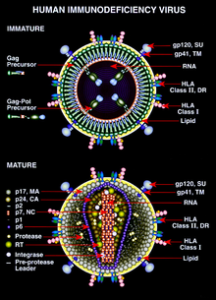 Amid the fanfare regarding initiatives to treat the devastating HIV/AIDS epidemic, a noteworthy finding has been overlooked. After more than two decades of debate, experimentation by patients, and scattered clinical testing of non-drug therapies of HIV, we now know much better which ones actually work.
Amid the fanfare regarding initiatives to treat the devastating HIV/AIDS epidemic, a noteworthy finding has been overlooked. After more than two decades of debate, experimentation by patients, and scattered clinical testing of non-drug therapies of HIV, we now know much better which ones actually work.
Most of those therapies vaguely and often dismissively termed Complementary and Alternative Medicine appear to have little effect against this ever-mutating, hard-to-control virus. Some of them cause side effects that disqualify them. Others, including hundreds of herbal remedies that have been tried and tested with a mixture of hope and desperation, have simply not stopped viral replication. There is no clear clinical evidence or scientific logic to support the claims of any of the traditional medicines of China, India, or other developing countries to stop the progress of HIV, let alone reverse its course.
Aware of this discouraging track record, many experts have concluded that natural approaches are uniformly ineffective, and that the only effective treatments are the standard protease inhibitors and other antivirals offered by the pharmaceutical industry. (If and when safe and effective vaccines against HIV can be developed and tested, of course, they will become critical weapons in the battle against the epidemic.)
Fortunately, these experts are wrong.
Three vs HIV
Like proteins edging forward along an electrophoretic plate, three close-to-Nature treatments of HIV have outpaced the pack of competitors. Each of the three is now being used against the epidemic in Africa and other places, with reported success. But little or no publicity.
The first is antioxidant therapy, primarily with Vitamins C and E. In two well-organized clinical trials reported in scientific journals, the combination of Vitamins C and E has been found to slow or stop disease progression in HIV/AIDS (Hughes, 2002; Allard et al., 1998). (Recent studies have found that intake of high-dose Vitamins C and E over extended periods of time can have harmful effects in cardiovascular patients, but there is no evidence of these effects when they are used in HIV/AIDS and respiratory disorders.)
Meanwhile, research continues to find that the antioxidant zinc has immunostimulative effects (Prasad, 2002). So it may well be that adding oral or transdermal zinc to Vitamins C and E can achieve even better results against HIV.
The second effective natural therapy of HIV is Homeopathy. Homeopathy has repeatedly outperformed other natural therapies in controlled clinical trials as an adjuvant treatment of HIV (Ullman, 2003). While many conventional medical researchers consider that the mechanisms of action of homeopathy are not known, this now appears incorrect. There is evidence that homeopathy has the same mechanisms of action as several biophysical therapies that are well characterized (Dillon, 2003). At any rate, the clinical data from repeated trials speak clearly: homeopathy has safe and effective action against HIV.
The third close-to-Nature therapy of HIV is Biophotonic Therapy, otherwise known as Photoluminescence, a treatment of the blood with small doses of light (Dillon, 1998, 2003, 2008). BT does not have the clinical trial record against HIV of antioxidant therapy or homeopathy because standard medical research funders have consistently refused to fund such trials, even though BT is the leading phototherapeutic treatment of infectious diseases. Still, BT is the subject of a dozen books and over 400 articles in the scientific literature. Its track record in clinical trials of other infectious diseases is uniformly excellent, and its mechanisms of action are well-characterized, though more work remains to be done. In effect, BT does not discriminate among pathogens; as a general immunostimulant, it treats them in the same safe and effective manner. BT is currently being used to treat HIV with anecdotal success in Africa and elsewhere.
Inexpensive, Few Side Effects
No other natural therapy than these three has thus far differentiated itself from the pack, though it is possible that several other such therapies are also effective against HIV.
Antioxidant therapy and homeopathy have been clearly shown to be effective by scientific evidence, while Biophotonic Therapy qualifies on the basis of its effectiveness against every infectious disease it has ever been tested against, its general antimicrobial mechanisms of action, and the anecdotal reports of its successful use in the field against HIV.
All three therapies possess the virtues of being inexpensive and having few or no side effects.
Allard, J.P. et al. (1998). “Effects of vitamin E and C supplementation on oxidative stress and viral load in HIV-infected subjects,” AIDS 12, pp. 1653-1659
Dillon, Kenneth J. (1998). Healing Photons. Washington, D.C.: Scientia Press
Dillon, Kenneth J. (2003). Close-to-Nature Medicine. Washington, D.C.: Scientia Press
Dillon, Kenneth J. (2008). Intriguing Anomalies: An Introduction to Scientific Detective Work. Washington, D.C.: Scientia Press
Hughes, David A. (2002), “Antioxidant Vitamins and Immune Function,” in Calder, Philip C., C.J. Field, and H.S. Gill. Nutrition and Immune Function. New York: CABI, pp. 171-191
Prasad, Ananda S. (2002), “Zinc, Infection and Immune Function,” in Calder, Philip C., C.J. Field, and H.S. Gill. Nutrition and Immune Function. New York: CABI, pp. 193-207
Ullman, Dana (2003), “Controlled Clinical Trials Evaluating the Homeopathic Treatment of People with Human Immunodeficiency Virus or Acquired Immune Deficiency Syndrome,” The Journal of Alternative and Complementary Medicine, Vol. 9, No. 1, pp. 133-141
*****
Kenneth J. Dillon is an historian who writes on science, medicine, and history. See the biosketch at About Us.
